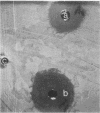Abstract
An inhibitory factor from Actinobacillus actinomycetemcomitans Y4 was isolated, and its properties indicated that it was a bacteriocin (actinobacillicin). The bacteriocin was active against Streptococcus sanguis strains, Streptococcus uberis (FDC1), and Actinomyces viscosus T14 as well as other strains of A. actinomycetemcomitans, but not against other crevicular bacteria, including other streptococci and actinomycetes. The activity of this bacteriocin was inhibited by pronase, trypsin, and heat (45 min at 56 degrees C) but not by DNase, RNase, phospholipase, exposure to UV light, or low pH (1.0 to 6.5). Although actinobacillicin markedly inhibited glycolysis in S. sanguis, the primary mechanism of its bactericidal action appears to be alterations in cell permeability, with the resultant leakage of RNA, DNA, and other essential intracellular macromolecules. These findings provide an ecologic explanation for the reciprocal growth relationship between A. actinomycetemcomitans and S. sanguis/Actinomyces viscosus observed in localized juvenile periodontitis.
Full text
PDF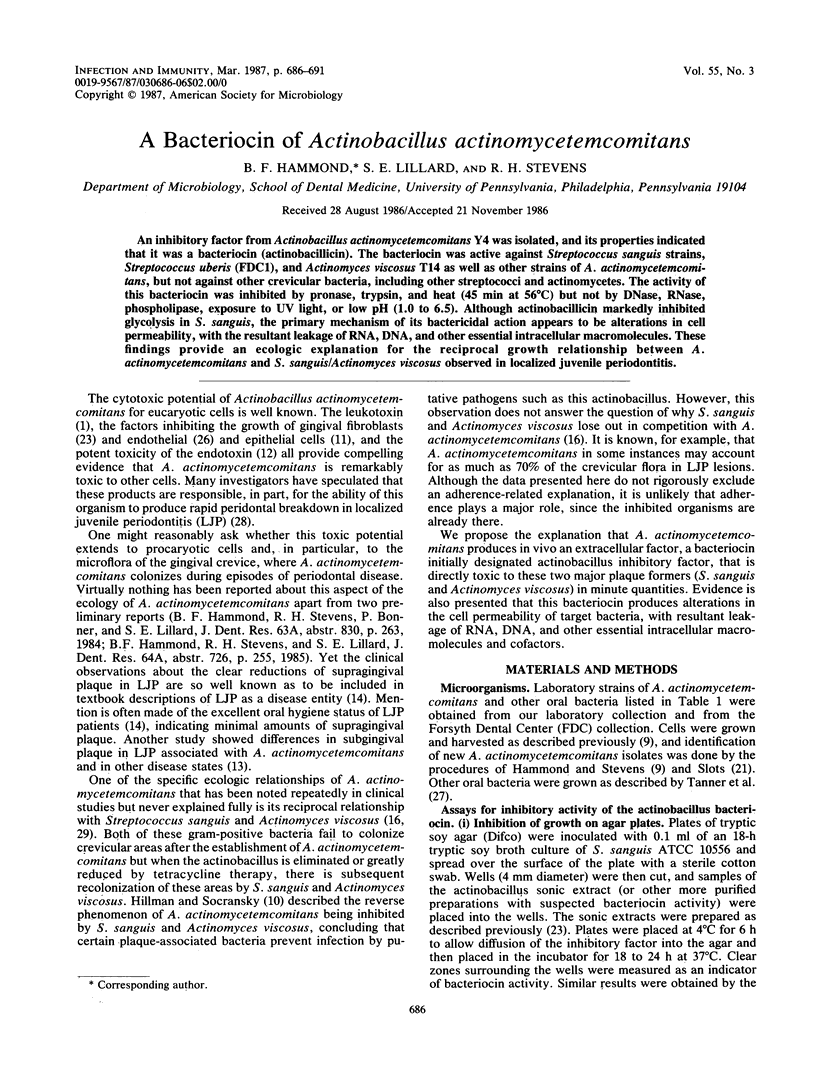
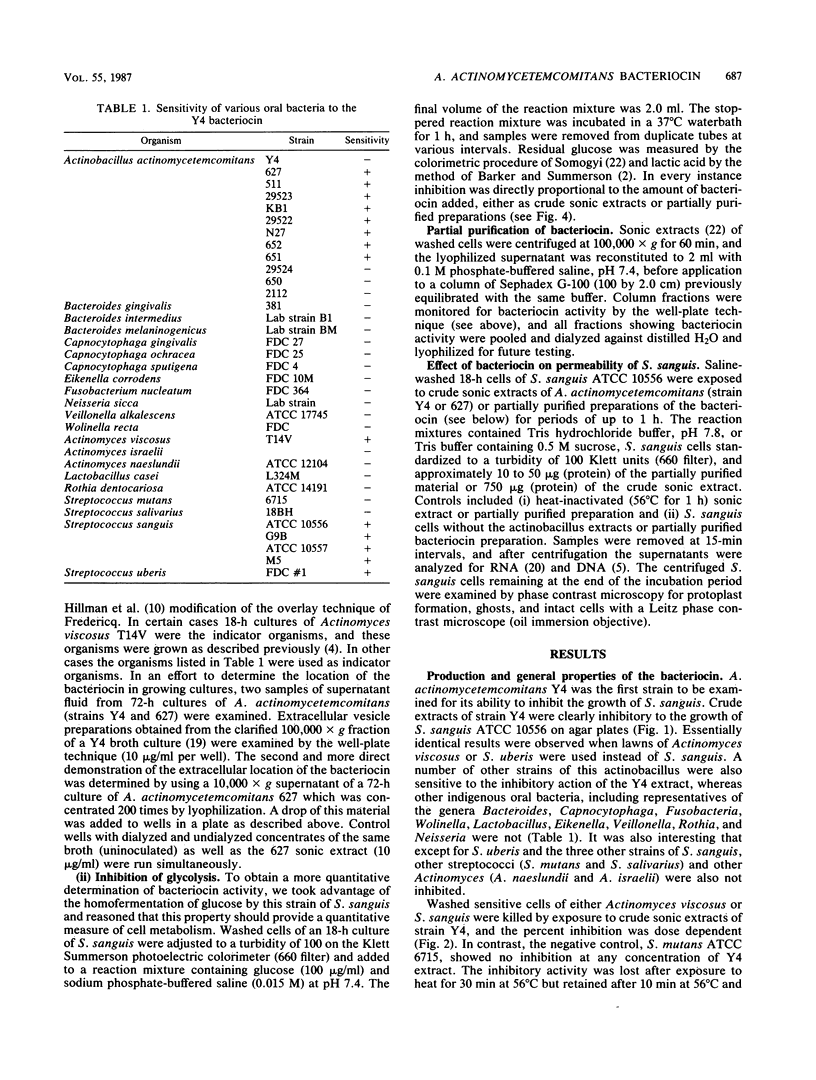
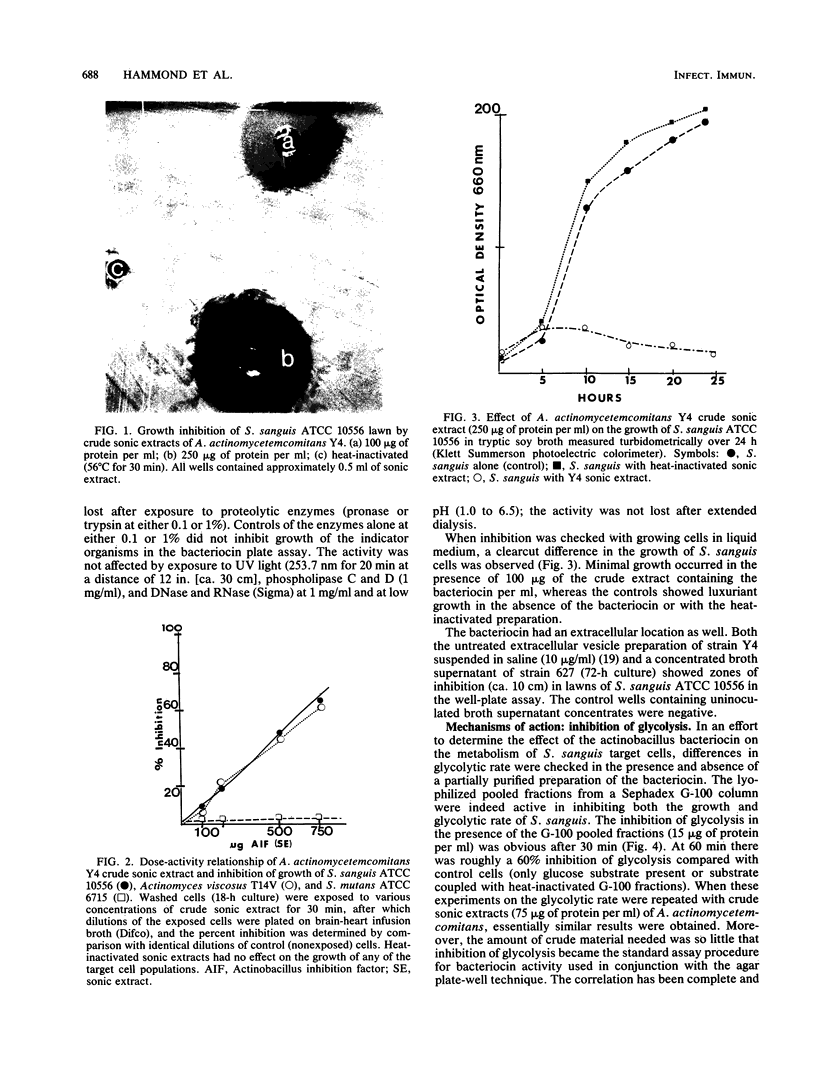
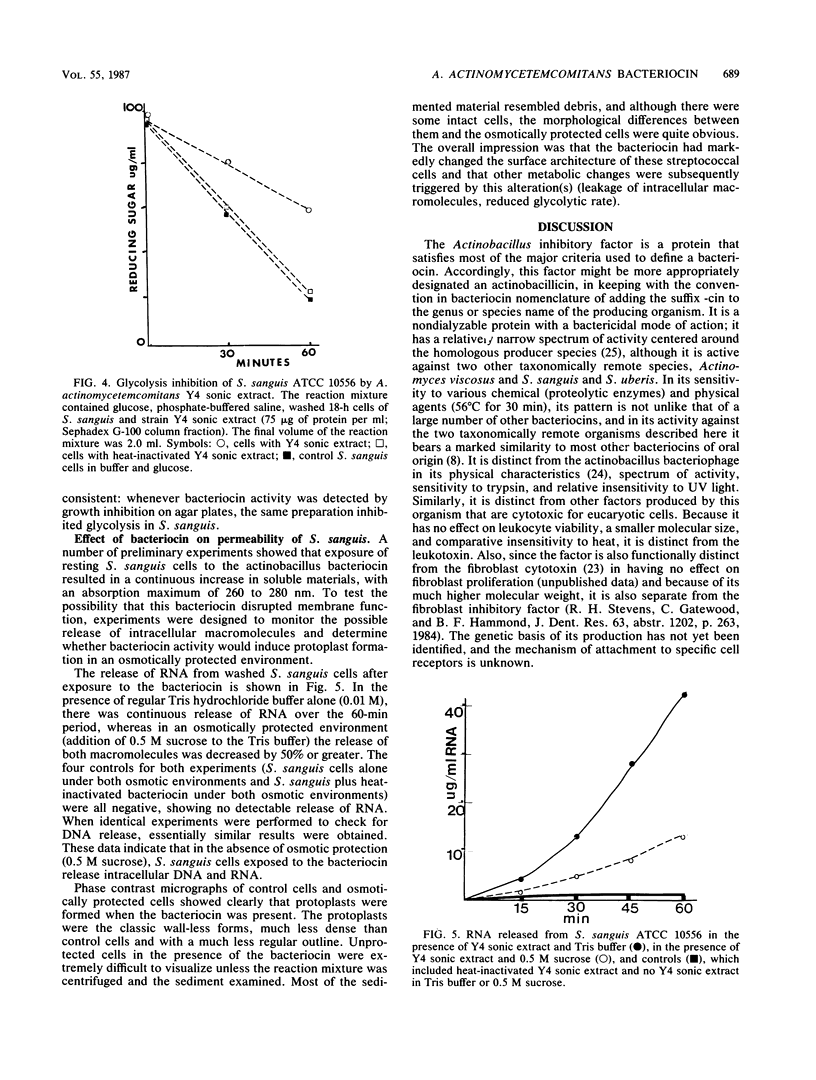
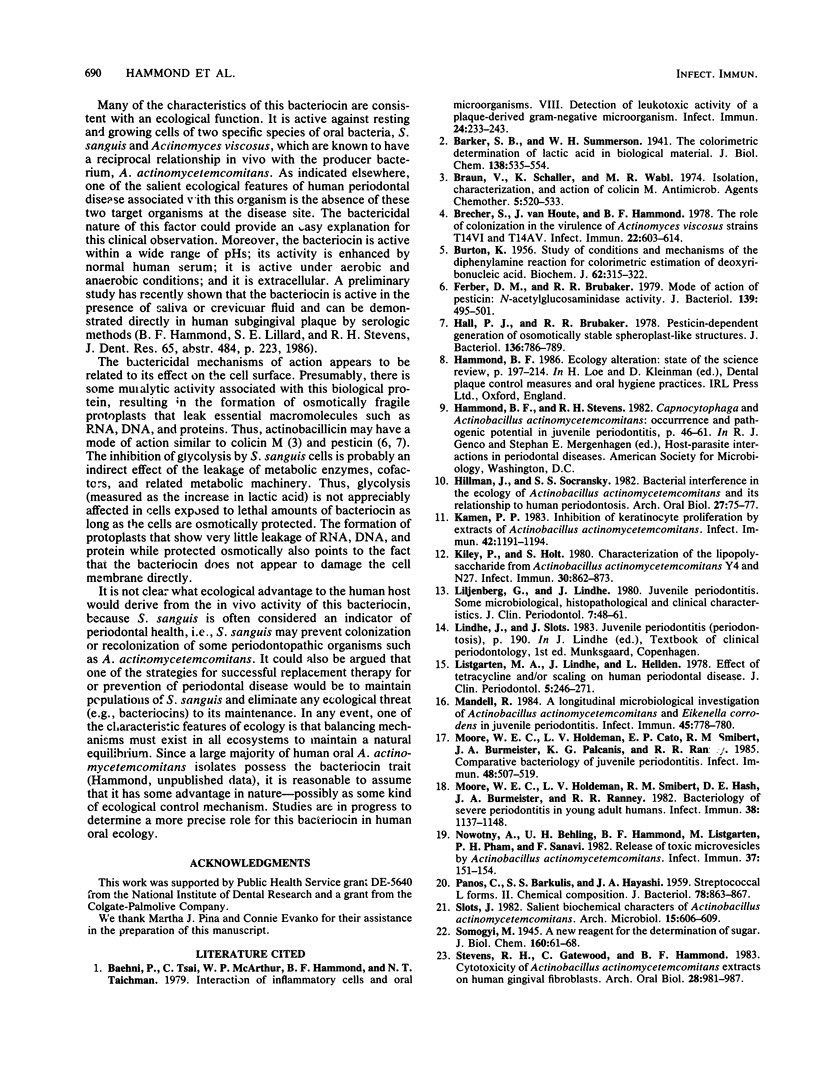
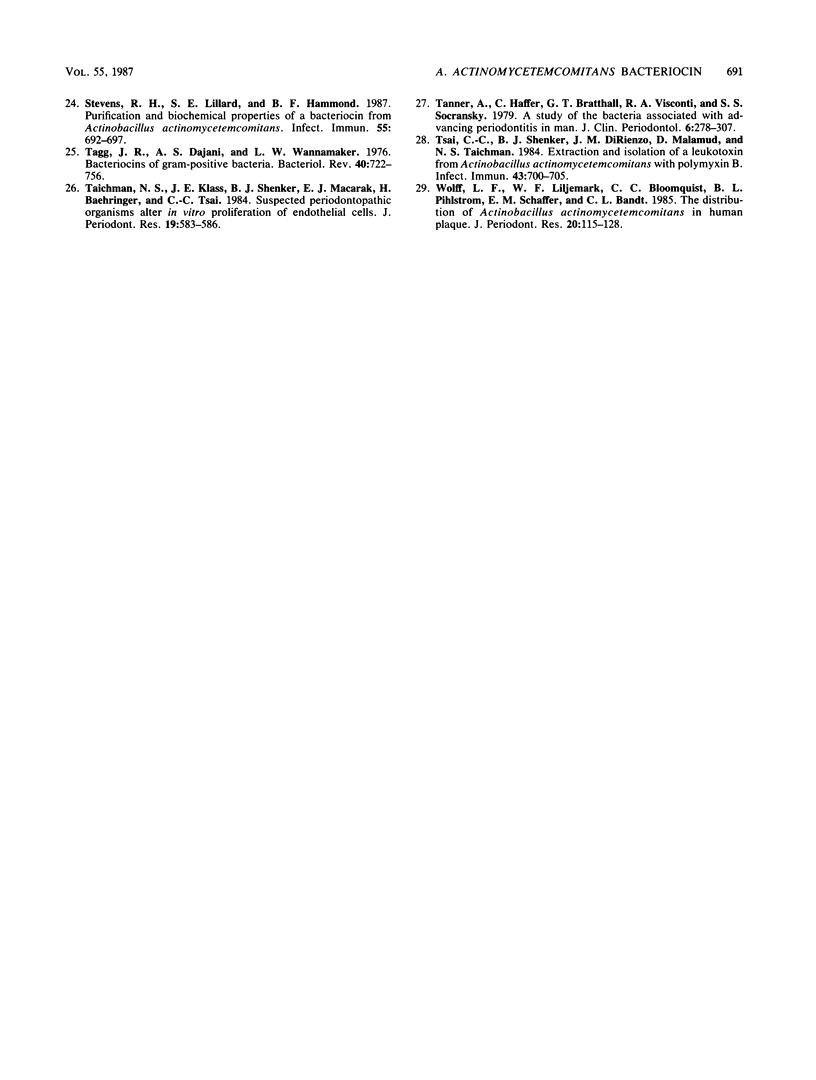
Images in this article
Selected References
These references are in PubMed. This may not be the complete list of references from this article.
- BURTON K. A study of the conditions and mechanism of the diphenylamine reaction for the colorimetric estimation of deoxyribonucleic acid. Biochem J. 1956 Feb;62(2):315–323. doi: 10.1042/bj0620315. [DOI] [PMC free article] [PubMed] [Google Scholar]
- Baehni P., Tsai C. C., McArthur W. P., Hammond B. F., Taichman N. S. Interaction of inflammatory cells and oral microorganisms. VIII. Detection of leukotoxic activity of a plaque-derived gram-negative microorganism. Infect Immun. 1979 Apr;24(1):233–243. doi: 10.1128/iai.24.1.233-243.1979. [DOI] [PMC free article] [PubMed] [Google Scholar]
- Braun V., Schaller K., Wabl M. R. Isolation, characterization, and action of colicin M. Antimicrob Agents Chemother. 1974 May;5(5):520–533. doi: 10.1128/aac.5.5.520. [DOI] [PMC free article] [PubMed] [Google Scholar]
- Brecher S. M., van Houte J., Hammond B. F. Role of colonization in the virulence of Actinomyces viscosus strains T14-Vi and T14-Av. Infect Immun. 1978 Nov;22(2):603–614. doi: 10.1128/iai.22.2.603-614.1978. [DOI] [PMC free article] [PubMed] [Google Scholar]
- Ferber D. M., Brubaker R. R. Mode of action of pesticin: N-acetylglucosaminidase activity. J Bacteriol. 1979 Aug;139(2):495–501. doi: 10.1128/jb.139.2.495-501.1979. [DOI] [PMC free article] [PubMed] [Google Scholar]
- Hall P. J., Brubaker R. R. Pesticin-dependent generation of somotically stable spheroplast-like structures. J Bacteriol. 1978 Nov;136(2):786–789. doi: 10.1128/jb.136.2.786-789.1978. [DOI] [PMC free article] [PubMed] [Google Scholar]
- Hillman J. D., Socransky S. S. Bacterial interference in the oral ecology of Actinobacillus actinomycetemcomitans and its relationship to human periodontosis. Arch Oral Biol. 1982;27(1):75–77. doi: 10.1016/0003-9969(82)90180-7. [DOI] [PubMed] [Google Scholar]
- Kamen P. R. Inhibition of keratinocyte proliferation by extracts of Actinobacillus actinomycetemcomitans. Infect Immun. 1983 Dec;42(3):1191–1194. doi: 10.1128/iai.42.3.1191-1194.1983. [DOI] [PMC free article] [PubMed] [Google Scholar]
- Kiley P., Holt S. C. Characterization of the lipopolysaccharide from Actinobacillus actinomycetemcomitans Y4 and N27. Infect Immun. 1980 Dec;30(3):862–873. doi: 10.1128/iai.30.3.862-873.1980. [DOI] [PMC free article] [PubMed] [Google Scholar]
- Liljenberg B., Lindhe J. Juvenile periodontitis. Some microbiological, histopathological and clinical characteristics. J Clin Periodontol. 1980 Feb;7(1):48–61. doi: 10.1111/j.1600-051x.1980.tb01948.x. [DOI] [PubMed] [Google Scholar]
- Listgarten M. A., Lindhe J., Hellden L. Effect of tetracycline and/or scaling on human periodontal disease. Clinical, microbiological, and histological observations. J Clin Periodontol. 1978 Nov;5(4):246–271. doi: 10.1111/j.1600-051x.1978.tb01918.x. [DOI] [PubMed] [Google Scholar]
- Mandell R. L. A longitudinal microbiological investigation of Actinobacillus actinomycetemcomitans and Eikenella corrodens in juvenile periodontitis. Infect Immun. 1984 Sep;45(3):778–780. doi: 10.1128/iai.45.3.778-780.1984. [DOI] [PMC free article] [PubMed] [Google Scholar]
- Moore W. E., Holdeman L. V., Cato E. P., Smibert R. M., Burmeister J. A., Palcanis K. G., Ranney R. R. Comparative bacteriology of juvenile periodontitis. Infect Immun. 1985 May;48(2):507–519. doi: 10.1128/iai.48.2.507-519.1985. [DOI] [PMC free article] [PubMed] [Google Scholar]
- Moore W. E., Holdeman L. V., Smibert R. M., Hash D. E., Burmeister J. A., Ranney R. R. Bacteriology of severe periodontitis in young adult humans. Infect Immun. 1982 Dec;38(3):1137–1148. doi: 10.1128/iai.38.3.1137-1148.1982. [DOI] [PMC free article] [PubMed] [Google Scholar]
- Nowotny A., Behling U. H., Hammond B., Lai C. H., Listgarten M., Pham P. H., Sanavi F. Release of toxic microvesicles by Actinobacillus actinomycetemcomitans. Infect Immun. 1982 Jul;37(1):151–154. doi: 10.1128/iai.37.1.151-154.1982. [DOI] [PMC free article] [PubMed] [Google Scholar]
- PANOS C., BARKULIS S. S., HAYASHI J. A. Streptococcal L forms. II. Chemical composition. J Bacteriol. 1959 Dec;78:863–867. doi: 10.1128/jb.78.6.863-867.1959. [DOI] [PMC free article] [PubMed] [Google Scholar]
- Stevens R. H., Gatewood C., Hammond B. F. Cytotoxicity of the bacterium Actinobacillus actinomycetemcomitans extracts in human gingival fibroblasts. Arch Oral Biol. 1983;28(11):981–987. doi: 10.1016/0003-9969(83)90051-1. [DOI] [PubMed] [Google Scholar]
- Stevens R. H., Lillard S. E., Hammond B. F. Purification and biochemical properties of a bacteriocin from Actinobacillus actinomycetemcomitans. Infect Immun. 1987 Mar;55(3):692–697. doi: 10.1128/iai.55.3.692-697.1987. [DOI] [PMC free article] [PubMed] [Google Scholar]
- Tagg J. R., Dajani A. S., Wannamaker L. W. Bacteriocins of gram-positive bacteria. Bacteriol Rev. 1976 Sep;40(3):722–756. doi: 10.1128/br.40.3.722-756.1976. [DOI] [PMC free article] [PubMed] [Google Scholar]
- Taichman N. S., Klass J. E., Shenker B. J., Macarak E. J., Boehringer H., Tsai C. C. Suspected periodontopathic organisms alter in vitro proliferation of endothelial cells. J Periodontal Res. 1984 Nov;19(6):583–586. doi: 10.1111/j.1600-0765.1984.tb01319.x. [DOI] [PubMed] [Google Scholar]
- Tanner A. C., Haffer C., Bratthall G. T., Visconti R. A., Socransky S. S. A study of the bacteria associated with advancing periodontitis in man. J Clin Periodontol. 1979 Oct;6(5):278–307. doi: 10.1111/j.1600-051x.1979.tb01931.x. [DOI] [PubMed] [Google Scholar]
- Tsai C. C., Shenker B. J., DiRienzo J. M., Malamud D., Taichman N. S. Extraction and isolation of a leukotoxin from Actinobacillus actinomycetemcomitans with polymyxin B. Infect Immun. 1984 Feb;43(2):700–705. doi: 10.1128/iai.43.2.700-705.1984. [DOI] [PMC free article] [PubMed] [Google Scholar]



